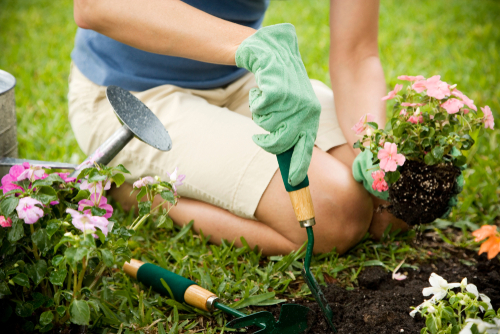Creating a drought-resistant garden is vital in today’s world with frequent and severe droughts. To conserve water, drought-resistant landscaping is an excellent option.
With the right plant selection and garden design, you can create an eco-friendly and sustainable outdoor space that will flourish even during droughts.
In this article, we’ll help you learn how to choose drought-resistant plants and design your garden to minimize water usage.

Understanding Drought-resistant Plants
Drought-resistant plants, also known as xerophytes, are plants that can survive with minimal water. They have adapted to dry and arid climates and are designed to store water efficiently or have other ways to survive periods of drought.
The benefits of using drought-resistant plants in landscaping are numerous. They require less water, reducing your overall water usage, and they can also save you money on your water bills. Additionally, because they can survive with minimal water, they are low-maintenance and require less care than other plants, making them a great option for busy homeowners.
There are many options for drought-resistant plants, and the choices will depend on your specific location and climate. Some popular options include succulents, lavender, yarrow, and sage. These plants are not only drought-resistant but also add beauty and diversity to your garden.
Factors to Consider in Garden Design
When designing a garden, it’s important to keep in mind the local climate and weather patterns, as well as the needs of the plants. For those living in drought-prone areas, it’s especially important to create a garden that minimizes water usage.
The first step in designing a drought-resistant garden is to assess the water needs of the plants. Different plants have different water requirements, and it’s important to choose plants that are well-suited to the local climate. Consider factors such as soil type, sun exposure, and wind patterns, as well as the amount of rainfall in your area.
Moreover, there are a number of strategies you can use to minimize water usage in your garden. One of the most effective is to group plants with similar water needs together, so that you can water them more efficiently. You can also use techniques such as mulching to help retain moisture in the soil, and choose plants that are tolerant of dry conditions.
When designing a garden, it’s also important to consider ways to reduce runoff and erosion. One way to do this is to create swales, or shallow channels in the soil, which can help to capture and retain rainwater. You can also use groundcovers or other plants with deep root systems to help stabilize the soil and reduce erosion.
Designing Your Drought-resistant Garden
When selecting plants for your garden, it’s important to choose species that are well-suited to your climate and soil conditions. Look for plants that have low to moderate water requirements and are adapted to drought-like conditions. Group plants with similar water needs together, and arrange them in a way that creates visual interest and texture.
In addition to plants, hardscaping elements like gravel, stone, and mulch can help reduce water usage in your garden. By creating permeable paths and incorporating mulch around your plants, you can help retain moisture in the soil and reduce water runoff.
To minimize water usage in your garden, it can be helpful to create zones based on the water needs of different plant species. For example, you might create a zone of drought-tolerant plants that require minimal watering, and a separate zone for plants that require more water.
Remember, designing a drought-resistant garden doesn’t have to mean sacrificing beauty or creativity. By selecting the right plants, incorporating hardscaping elements, and creating zones based on water needs, you can create a garden that is not only sustainable, but also visually appealing and enjoyable to spend time in.
Maintaining a Drought-resistant Garden
Maintaining a drought-resistant garden may seem daunting, but with the right techniques and tools, it can be a fulfilling and sustainable experience. Here are some tips on how to keep your garden healthy and thriving:
Watering and Irrigation Techniques
When it comes to watering your garden, it’s important to be mindful of your water usage. One effective method for reducing your water consumption is by using a rainwater tank. This allows you to collect and store rainwater for later use, which can significantly reduce your reliance on municipal water sources.
Other watering techniques that can help minimize water waste include using a soaker hose or drip irrigation system, which delivers water directly to the roots of your plants.
Pruning and Fertilizing
Pruning is an essential part of maintaining a healthy garden. It helps to promote plant growth, remove dead or damaged branches, and maintain the overall shape and structure of your plants. Fertilizing your garden can also be beneficial, as it provides essential nutrients to your plants and helps to keep them healthy. When choosing fertilizers, opt for organic options that are less harmful to the environment and safer for your family and pets.
Pest Control and Weed Management
Keeping pests and weeds at bay is a crucial aspect of maintaining a healthy garden. One approach to pest control is to use natural remedies, such as neem oil or insecticidal soap, which can be effective against a wide range of garden pests. For weed management, consider using mulch or ground covers to help suppress weed growth and reduce the need for manual weeding.
Takeaways
Creating a drought-resistant garden is an environmentally responsible and beautiful addition to your home. You can reduce water usage, save money, and create a stunning oasis even in dry conditions. To achieve this, select drought-resistant plants, use water-saving strategies, and maintain your garden properly. Don’t let a lack of rainfall dampen your gardening spirit. With these tips and tricks, you can design a sustainable and resilient landscape.
How to make the perfect cup of tea